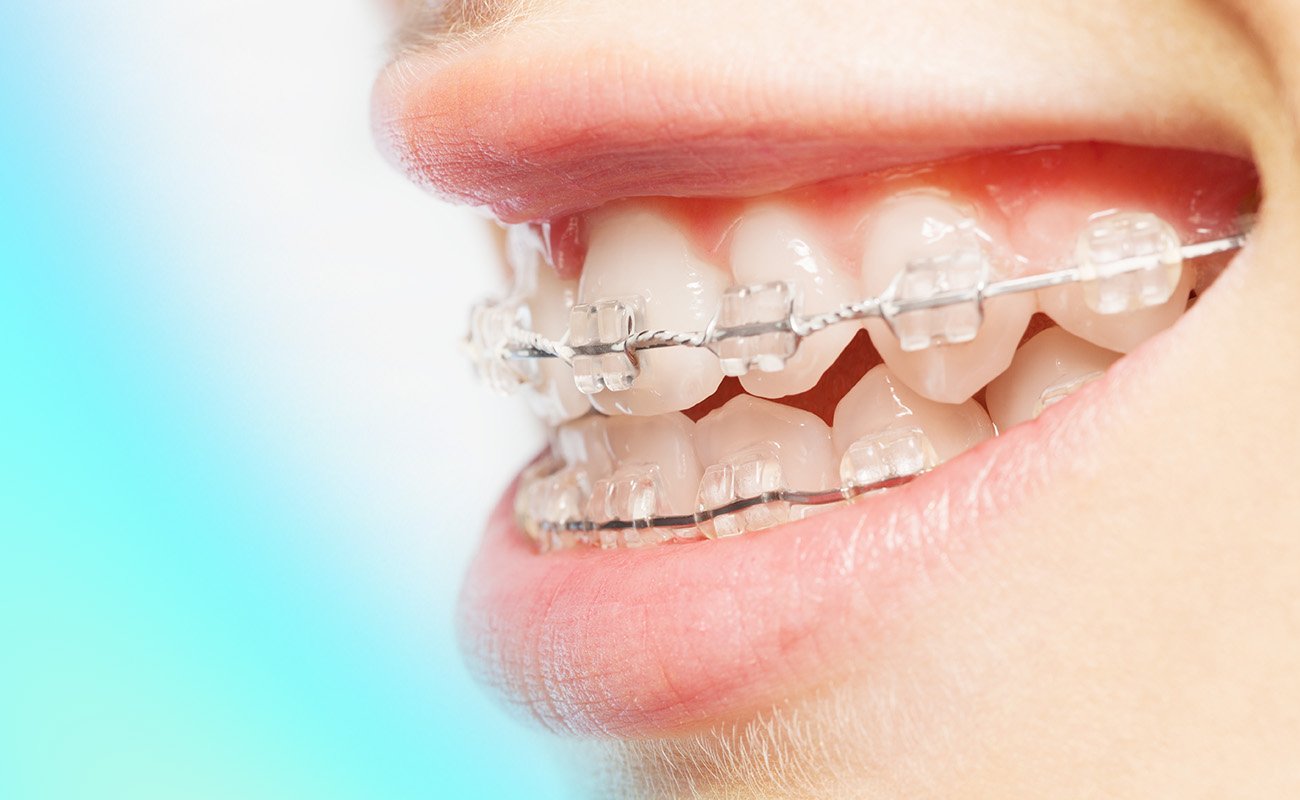Are you considering clear ceramic braces for straightening your teeth? Have you wondered if clear braces are as effective as traditional metal braces? As desire grows for more aesthetic teeth straightening options for both teens and adults, clear ceramic braces rise in popularity over old-fashioned metal wires and brackets. However, there are key factors around treatment length, discomfort levels, and results to weigh when deciding between metal or clear braces.
This article explores common questions about clear ceramic braces for upper and lower teeth. We’ll cover the differences between clear ceramic and metal braces, including unique pros and cons. We’ll look at whether clear fixed brackets can be worn only on the top or bottom arch or if both must be treated simultaneously. And we’ll consider alternatives beyond just clear ceramic versus metal orthodontic treatments. Read on for the details you need to determine if clear fixed braces could be the right fit for your smile goals.
What is the Difference Between Metal and Clear Braces?
Metal braces and clear braces are both effective orthodontic treatments designed to straighten teeth, improve oral health, and enhance smile aesthetics. The primary difference between the two lies in their materials and visibility.
Metal braces, made from high-grade stainless steel, are known for their robustness and effectiveness in treating a wide range of orthodontic issues, from simple to complex cases. They consist of metal brackets that are attached to each tooth and connected by a thin archwire, which is periodically tightened to guide teeth into their correct positions. Metal braces are highly durable and can withstand most types of everyday wear and tear
On the other hand, clear braces are constructed from ceramic or plastic materials, which are designed to blend in with the natural color of your teeth, offering a less noticeable alternative. While clear braces provide a more aesthetic option for patients concerned about the appearance of braces, they may require more careful maintenance and can be slightly less durable than their metal counterparts.
Worth Knowing
The study published on PubMed Central reveals that a significant number of adults favor discreet orthodontic solutions like aligners or clear braces.
Pros and Cons of Clear Braces
Clear braces offer several advantages for those wanting to straighten their teeth. Firstly, clear braces are designed to align teeth with minimal visual impact, matching closely with the color of teeth for a less noticeable effect. Additionally, they are made from materials such as ceramic or high-quality plastic, which can provide a more comfortable experience than traditional metal braces, potentially causing less irritation. The design of clear braces, featuring fewer brackets and wires, can also facilitate easier cleaning and maintenance.
While these benefits may seem attractive it is important to consider the drawbacks of clear braces before deciding if this is the right option for you. The most common disadvantage is their higher cost compared to traditional metal braces. Moreover, the materials used in clear braces may be more susceptible to damage, which could interrupt the treatment process and extend the duration needed to achieve desired results. The treatment time might also be extended with clear braces, as they may require a slower and more cautious application of orthodontic forces due to their material properties.
The brackets of clear braces are larger than metal, and the use of clear rubber bands or clips, necessary for holding the archwire in place, might be prone to staining, especially from certain types of food and drink, which could compromise their aesthetic advantage.
See also: What Stains Ceramic Braces? Causes and Prevention Tips
Can You Have Clear Braces on the Bottom Teeth Only? Can You Have Clear Braces on the Top Teeth Only?
Now that we’ve weighed the pros and cons of clear ceramic braces, it’s worth discussing the possibility of having clear braces applied to just the bottom or top teeth. This method, known as a ‘mixed’ braces approach, allows patients to combine the aesthetic advantages of clear braces on one arch with the strength and cost benefits of traditional metal braces on the other.
For many, the top teeth are a priority when it comes to aesthetics, as they are more visible during smiling and talking. In such cases, clear braces on the upper teeth can provide a discreet treatment option, minimizing the visual impact of orthodontic work. On the lower arch, where braces are less noticeable, metal braces can be an effective choice, offering durability and efficiency in aligning teeth.
This hybrid approach caters to a wide range of needs and preferences. It allows patients to enjoy the less conspicuous nature of clear braces where it matters most to them, while also taking advantage of the robustness and affordability of metal braces.
See our article: Alternative to Braces for Adults.
Alternative to Clear Braces
If you’re considering an aesthetic solution for straightening your teeth and have been thinking about clear ceramic braces, you might want to also consider clear aligners as an alternative. Clear aligners offer a nearly invisible way to improve your smile, standing out for their subtlety compared to even the less noticeable clear braces. One of the biggest perks of clear aligners is their comfort and the convenience of being able to remove them. This feature is a game-changer for maintaining oral hygiene, as you can brush and floss without the hassle of navigating around braces.
See our article: Types of Invisible Braces.
Here are some reviews of the best at-home clear aligners you can opt for:
AlignerCo is a well-known brand that provides an affordable aligner program. Their prices are lower than most other aligner brands, with treatment starting at just $945, which also includes free retainers and a teeth whitening kit.

AlignerCo
The cheapest at-home aligners, with monthly plans, no down payment, and considerable discounts.
Check out AlignerCo AlignersNewSmile is one of the newest aligner brands on the market and is known for its affordability. When you purchase their aligners, you receive an impression kit, whitening foam, aligners, and retainers. This brand also provides monthly payment plans without requiring any initial payments, offers a video call option with a specialist to assist with mouth impressions, and has a user-friendly online assessment process.

NewSmile
Affordable at-home treatment with positive reviews offering superior look and comfort.
Check out NewSmile AlignersByte is a well-known brand that offers a lifetime guarantee for your aligners. This means that if your teeth don’t stay in the desired treatment position afterward, you’ll receive additional impression kits, treatment plans, and sets of aligners at no additional cost to correct any misalignments.

Byte
An affordable option with refundable impression kits, free HyperByte, and a Byte for Life guarantee.
Check out Byte AlignersCandid is a highly regarded aligner product with a treatment approach similar to Invisalign. Unlike the other brands mentioned, Candid doesn’t offer a direct-to-home ordering service. Instead, a qualified orthodontist will assess your eligibility for treatment. The advantage is that you won’t need regular appointments after starting treatment. Candid aligners are suitable for addressing both mild and severe spacing issues.

Candid
A hybrid of in-office and at-home treatment that provides 1-on-1 orthodontist support.
Check out Candid AlignersClear Braces on the Top and Bottom Teeth – Can You Have Them on Both Arches? Can You Put Them on at the Same Time?
Clear braces are designed to closely match the natural color of teeth, making them a suitable and visually appealing choice for orthodontic treatment on both the upper and lower teeth. This option is particularly favored by those who seek a more uniform appearance, as it lessens the visual impact associated with traditional orthodontic treatments.
Applying clear braces to both arches simultaneously is not only feasible but also can lead to more efficient treatment outcomes. By treating both the upper and lower teeth at the same time, orthodontists can take a balanced approach to address dental misalignments, which can result in a more coordinated adjustment of the overall bite and jaw alignment. This method can streamline the treatment process, possibly shortening the time required to wear braces and easing the transition to the final alignment of the teeth.
Clear braces are often recommended by orthodontists for patients looking for an effective treatment that maintains a natural appearance of their smile throughout the process. The dual-arch application of clear braces is advocated for its ability to provide comprehensive orthodontic results while meeting the patient’s preference for a less noticeable treatment option.
Sources
Ke, Y., A comparison of treatment effectiveness between clear aligner and fixed appliance therapies. BMC Oral Health. 2019. doi: 10.1186/s12903-018-0695-z Available online at: https://www.ncbi.nlm.nih.gov/pmc/articles/PMC6343314/
Alansari, R. A., Faydhi, D. A., Ashour, B. S., Alsaggaf, D. H., Shuman, M. T., Ghoneim, S. H., Linjawi, A. I., Marghalani, H. Y., Dause, R. R., Adult Perceptions of Different Orthodontic Appliances, PubMed Central. 2019; DOI: 10.2147/PPA.S234449. Available online at: https://www.ncbi.nlm.nih.gov/pmc/articles/PMC6916694/
Olsen, J., Comparison of Patient Factors Influencing the Selection of an Orthodontist, General Dentist, or Direct-To-Consumer Aligners for Orthodontic Treatment. Virginia Commonwealth University. (2019). Available online at: https://scholarscompass.vcu.edu/cgi/viewcontent.cgi?article=6855&context=etd
Buschang, P.H., Shaw S.G., Ross M., Crosby D., Campbell P.M., Comparative time efficiency of aligner therapy and conventional edgewise braces. Angle Orthod (2014). DOI: 10.2319/062113-466. Available online at: https://meridian.allenpress.com/angle-orthodontist/article/84/3/391/58505/

